Last week it was revealed that the statues of George Hardwick and Wilf Mannion are to be joined by a statue of George Camsell – Middlesbrough FC’s greatest ever goalscorer and long-term club servant.
Boro historian Dr Tosh Warwick, currently writing the biography of the Boro and England legend, reflects on the story of the Framwellgate Moor born pit boy whose statue is to adorn the Riverside Stadium’s third plinth…

George the Great
George Camsell is undoubtedly one of the most important figures in the history of Middlesbrough Football Club. Signed from Durham City in 1925, the youngster enjoyed a steady start to life at Middesbrough FC and was initially on the peripheries of the first team – although scored for fun in the reserves - before making an incredible breakthrough in the 1926/27 season.
In that campaign, Camsell helped Middlesbrough to promotion to the First Division with a record-breaking 59 league goals. Although Camsell’s record was surpassed the following campaign with Dixie Dean’s 60 top-flight goals for Everton, the outstanding campaign with which Camsell is associated is far from the whole Camsell story.
At international level, Camsell would go on to score 18 goals in just 9 international appearances for England and would continue to dominate the goalscoring charts for his club into the mid-1930s and scored goals into the 1940s – alongside work in local industry – as war ravaged Europe. In the Boro record books, Camsell’s official goals tally for the club is 345 goals in 453 league and cup games but in reality, his tally factoring in further appearances is in excess of 360 goals.
After retiring from playing, the former Esh Winning and Tow Law star went on to serve the club behind the scenes, coaching local youngsters and helping discover Boro stars of the future.

A timely tribute
Camsell is arguably less known to many Boro fans than the three former Boro players already commemorated with statues in the town – namely Brian Clough (at Albert Park) and Hardwick and Mannion (at the Riverside Stadium). Camsell’s death in 1966 after almost four decades associated with Middlesbrough FC might explain why up until now he has not been commemorated in bronze, with the Mannion, Hardwick and Clough more immediate in the memories of former players and fans.
However, the impending new statue is a timely commemoration of the man possessing an England and Boro goalscoring record almost certain never to be bettered as the centenary of Camsell joining the club approaches. The new statue also builds upon existing commemorations of the former Boro forward, including a street near to the site of Ayresome Park taking his name and his 1998 selection as one of the ‘Football League 100 Legends’.
Over the decades there have been calls from historians, supporters and the wider football world – myself included – for Camsell to be memorialised at the Riverside. Mitrovic’s goalscoring feats of the previous season that broke Championship records but not second-tier records, brought an interview with The Times in which I shared George’s story with a national audience and pointed to the need for recognition of Camsell’s achievements. Experts such as my University of Sheffield colleague Dr Chris Stride have also highlighted how across ‘the Beautiful Game’– including in Middlesbrough - football clubs have relocated to new stadiums, left much of their heritage behind with the demolition of historic grounds, and installed new statues at their new homes as a way to connect with their history.
The forthcoming Camsell statue at the Riverside Stadium not only celebrates an Ayresome Park hero but reflects a recognition of the importance of remembering football history and the Boro story beyond the major trophy winning Riverside years. It also provides long overdue recognition of a great servant just as how travelling Boro fans have seen Camsell contemporaries such as Dixie Dean and Sir Stanley Matthews remembered at Everton and Stoke City respectively.

At a personal level, over the past couple of years working with the Camsell family, delving into the club archives, discovering supporter collections and reading the stories of his peers, the gravitas, greatness and esteem in which George was and is held has become more apparent by the day and recognition through a statue underlines this. Amongst many tributes uncovered to the Boro forward is that from Sir Stanley Matthews, who in his own autobiography declared ‘George Camsell was a great player and the mind boggles at what value would be put on a player with that scoring rate today’.
Memories of Camsell from former players he helped recruit through to interviews with family members have revealed George as an unassuming man who provoked awe from the Ayresome terraces and enjoyed the respect of the wider football world as an outstanding goalscorer, gentleman and someone with a keen eye for emerging talent just as he had for goal. In fact, it was Camsell who helped unearth fellow goalscoring machine Brian Clough and during a 1990s visit to Ayresome Park, the twice European Cup-winning Nottingham Forest manager declared ‘George Camsell was the one who signed me, he was a very famous centre forward…and was reputed to be the bravest centre forward in the whole of the Football League. I’ve got to thank George Camsell for getting me on forms for Middlesbrough.”
Now it is fitting that the gratitude felt by Clough to Camsell is extended through Sean Hedges Quinn’s creation of the pit boy turned powerful goalscoring phenomena that will soon proudly dominate a plinth in the town he made his home and at the club where he was so dearly loved.


